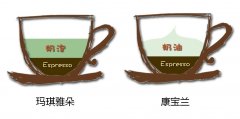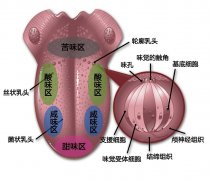The difference between a cappuccino and a latte
The difference between a cappuccino and a latte
Recently, at least five students in the class asked me the same question at the same time: what is the difference between a Cappuccino and a Latte?
Today, I will thoroughly analyze this problem with you.
First of all, I would like to correct a problem: Latte. The word Latte is in Italian and literally translates to mean milk. So latte is not the same as coffee. There are several lattes on the market that do not contain a drop of coffee, such as matcha lattes and cafe bene lattes from South Korean cafes. These are coffee-free, but they must contain milk. So the correct name should be cafe latte.
OK, look at the picture before you explain.
Composition difference: as can be found in the composition diagram below, the ingredients of the two kinds of coffee are the same. Espresso (espresso) and milk (milk foam is milk, of course). The difference is that there is more than one bubble and one more milk. (Latte means milk, so remember that more milk is latte.)
Appearance difference: there are a few more details in the figure:
1. Cappuccino has thick foam and the edge of the cup, but lattes are not needed.
2. According to the physical picture, the cup of latte is bigger than the cappuccino cup. (this can increase the amount of milk)
The three coffees of WBC (World Barista Competition) are: espresso (espresso), cappuccino (Cappuccino), and creative coffee. The competition stipulates that the foam thickness of cappuccino is not less than that of 1CM.
Important Notice :
前街咖啡 FrontStreet Coffee has moved to new addredd:
FrontStreet Coffee Address: 315,Donghua East Road,GuangZhou
Tel:020 38364473
- Prev

Macchiato and Con Panna
Macchiato and Con Panna always surprise everyone. Everyone's eyes tell me, is it really such a small cup? Yes, it is such a small cup. The word "Macchiato" comes from Italy, which means imprint or brand. Known as caramel macchiato, which means sweet imprint, this coffee is original for Starbucks. What Macchiato did was
- Next

Taste map!
With regard to taste maps, coffee and red wine are often used in tasting. Taste refers to the ability to sense the taste of substances, including the taste of food, certain minerals and toxic substances, which is close to the sense of smell, which is also chemically induced. Western experts have traditionally believed that taste consists of four basic flavors: sweet, salty, sour and bitter.
Related
- Beginners will see the "Coffee pull flower" guide!
- What is the difference between ice blog purified milk and ordinary milk coffee?
- Why is the Philippines the largest producer of crops in Liberia?
- For coffee extraction, should the fine powder be retained?
- How does extracted espresso fill pressed powder? How much strength does it take to press the powder?
- How to make jasmine cold extract coffee? Is the jasmine + latte good?
- Will this little toy really make the coffee taste better? How does Lily Drip affect coffee extraction?
- Will the action of slapping the filter cup also affect coffee extraction?
- What's the difference between powder-to-water ratio and powder-to-liquid ratio?
- What is the Ethiopian local species? What does it have to do with Heirloom native species?

